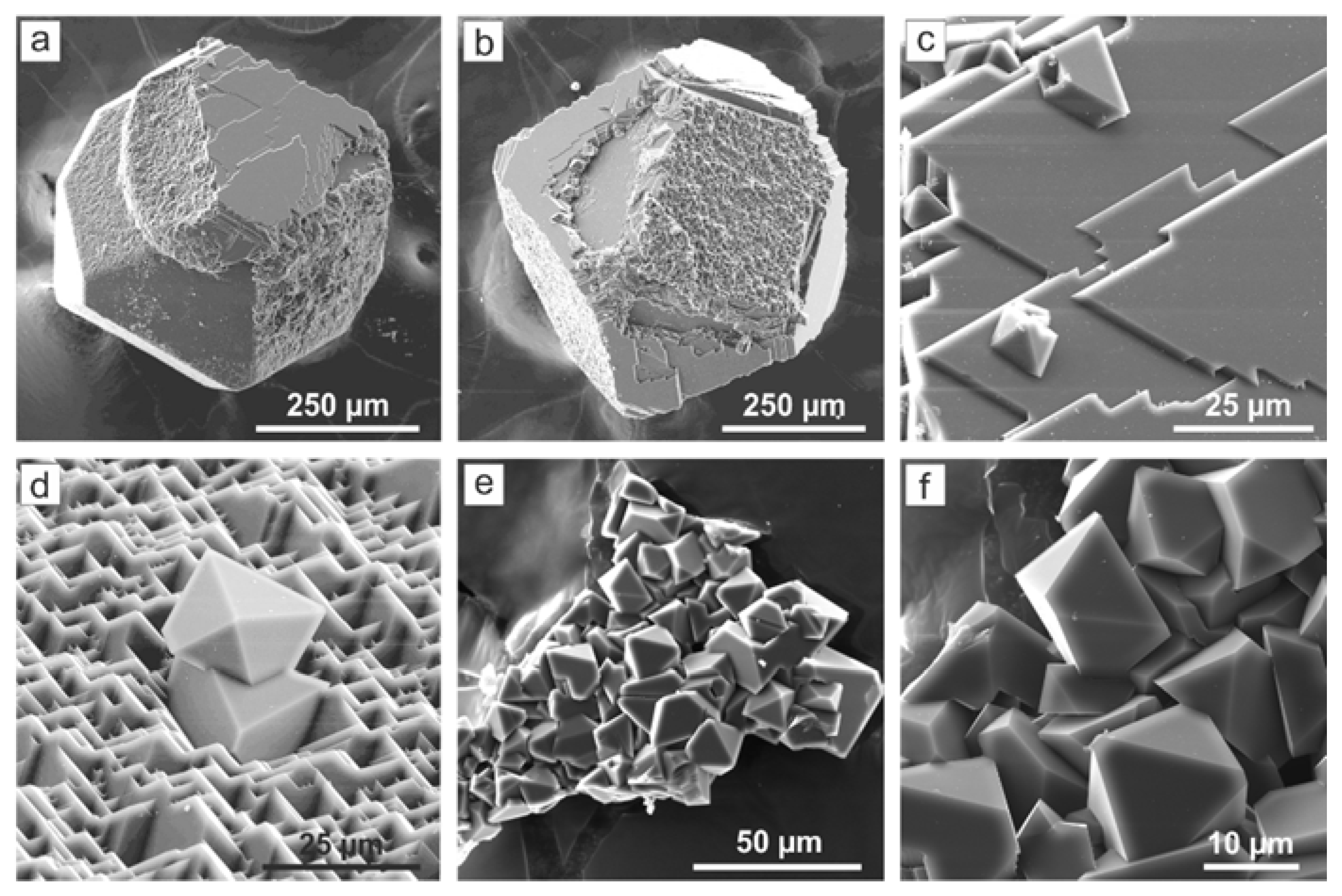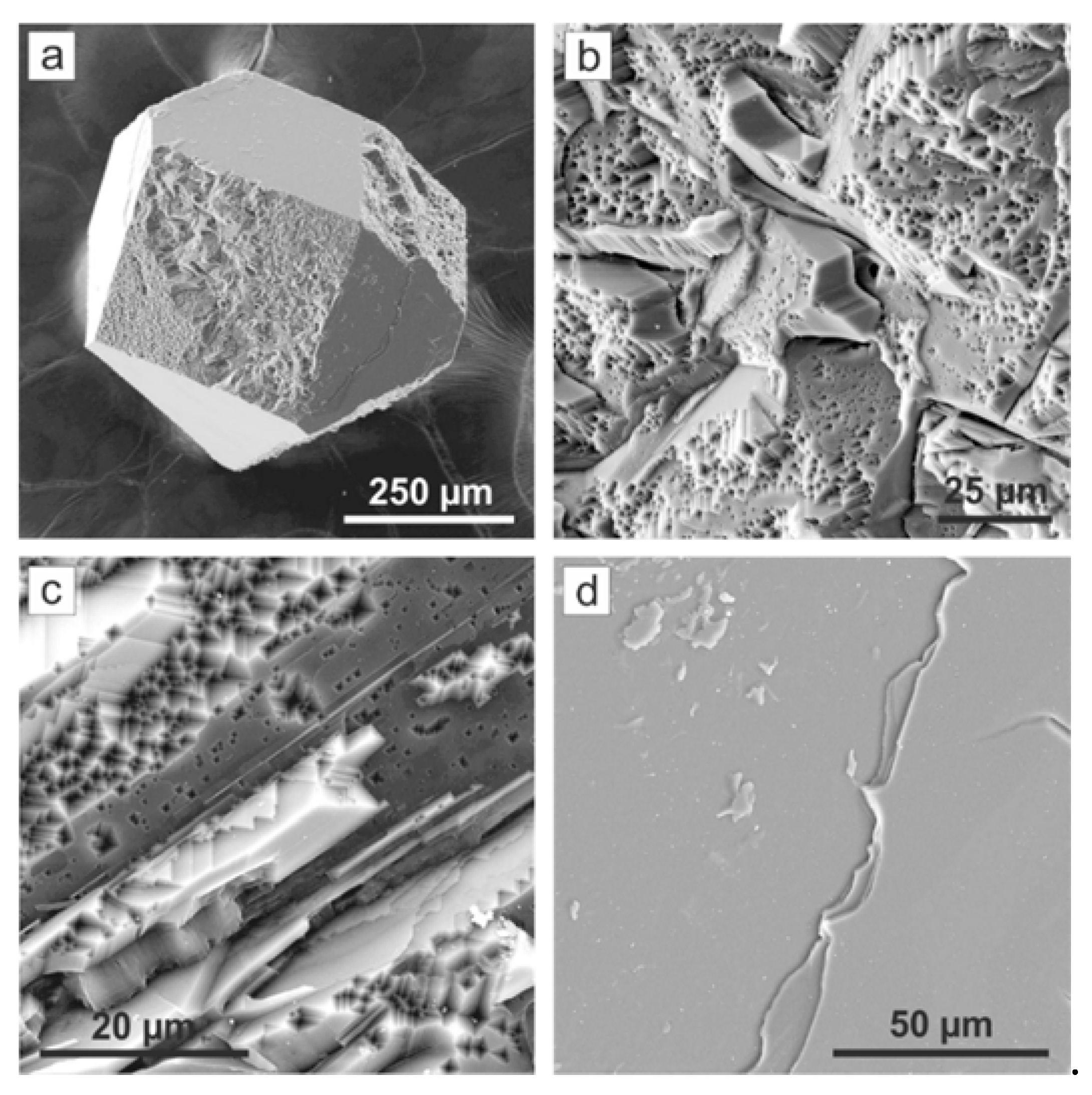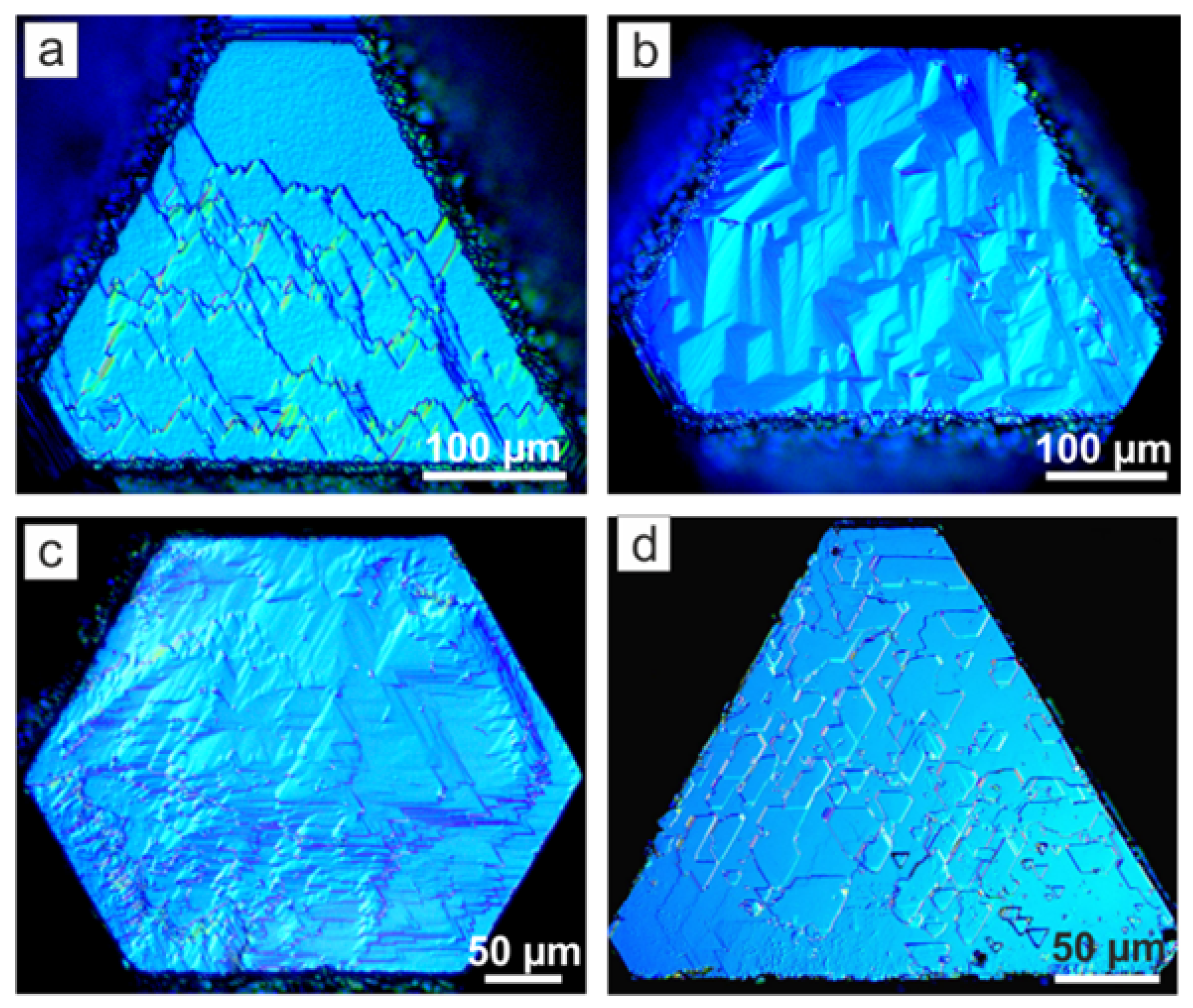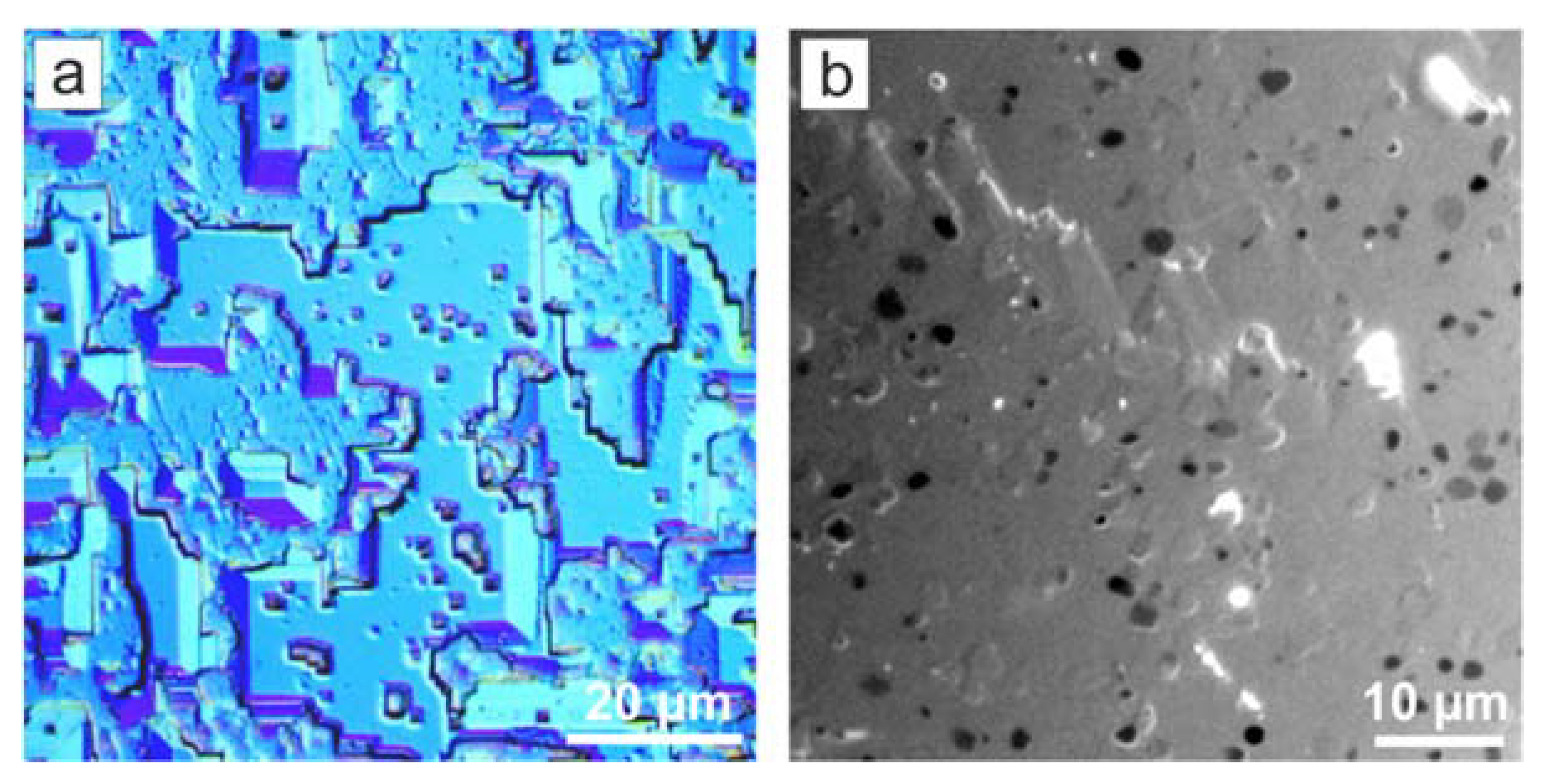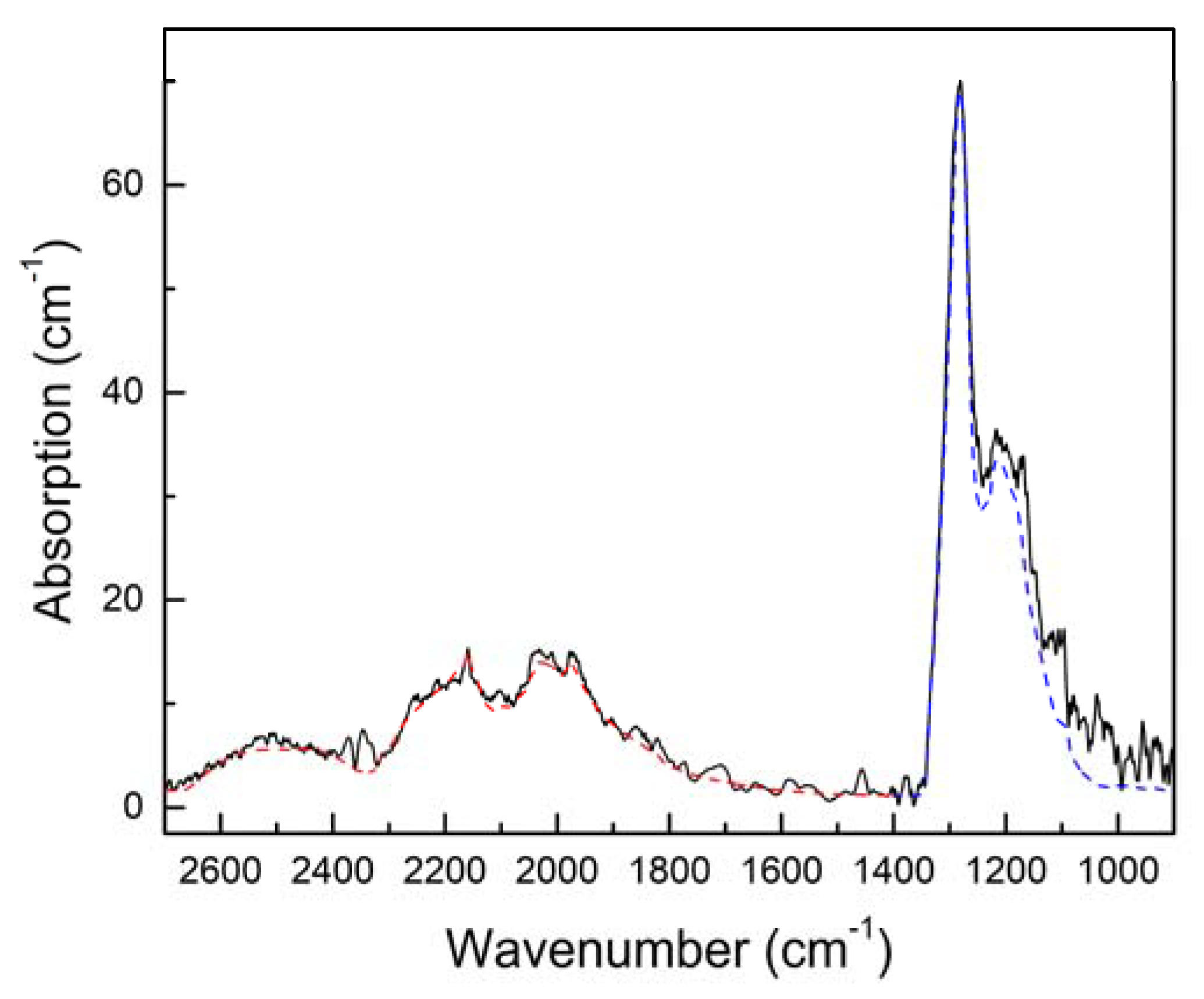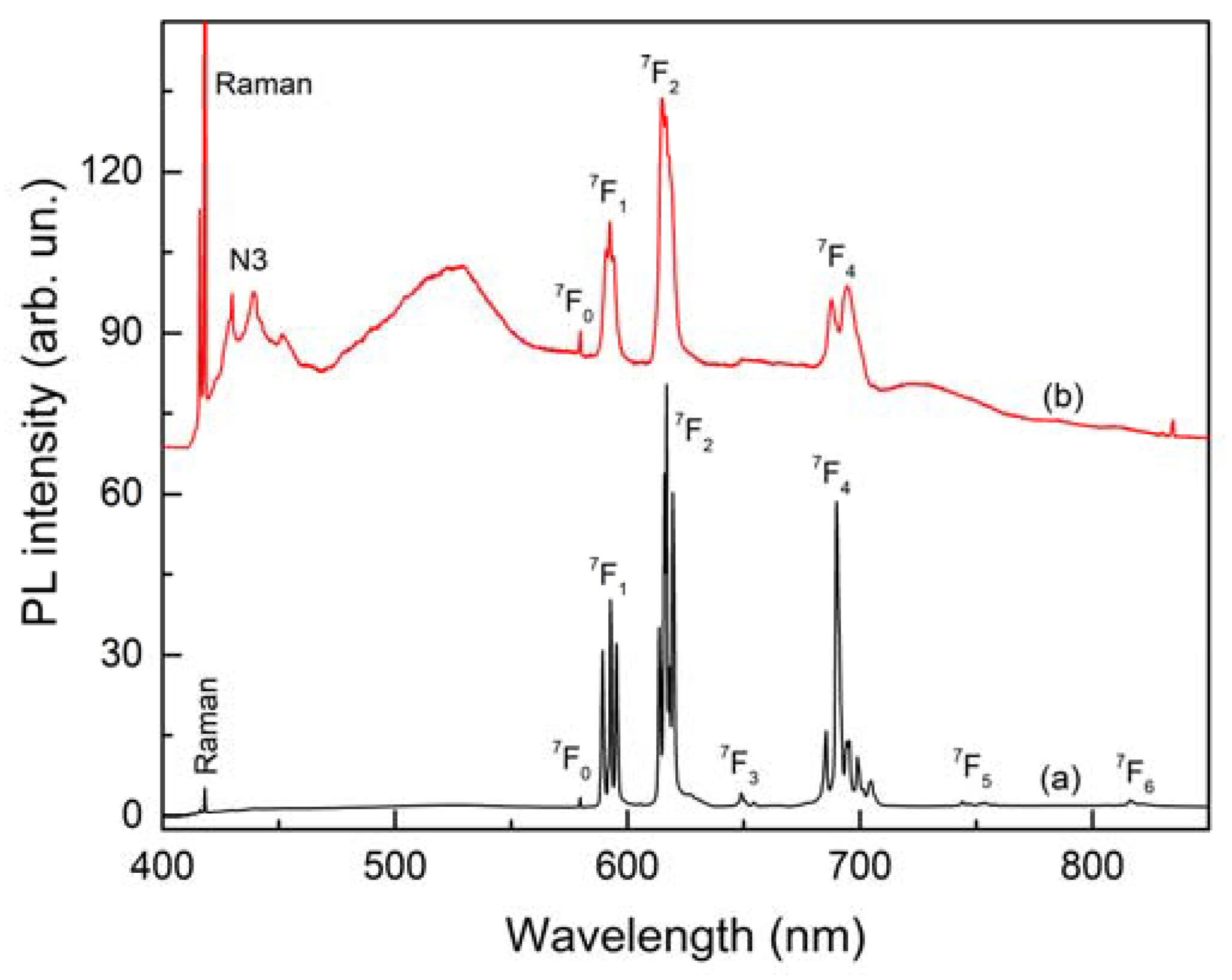3.1. Diamond Crystallization
The choice of starting experimental parameters was based on our studies of diamond crystallization in magnesium–RE systems [
7,
8]. Therefore, the first experiments on diamond synthesis in molten europium salts were carried out at a pressure of 7.8 GPa, a temperature of 1800 °C, and a run duration of 60 min. The experimental results demonstrated the lack of diamond synthesis and no growth on seed crystals at these parameters. In all experiments, metastable graphite was detected (
Table 1). An increase in the run time to 120 min at 1800 °C in EuCl
3+C and Eu
2(CO
3)
3·3H
2O+C systems (runs ES-2 and ES-6) did not result in diamond synthesis and growth on seeds. For this reason, the experimental temperature was elevated to 2000 °C, with a run time of 120 min being unchanged. In all experiments at 2000 °C in europium salts, there was diamond growth on the {111} and {100} faces of seed crystals (
Table 1). In this case, the thickness of newly formed diamond layers differed significantly. There was no problem in determining the thickness of overgrown layers. After the experiment, seed crystals were found to be pressed into the graphite capsule to varying degrees. Growth of the newly formed diamond occurred only towards melts of RE salts, and the faces of a seed diamond in graphite remained almost unchanged or were slightly dissolved. As a result, a distinct step in the diamond relief was formed at the graphite–salt melt salt boundary. This is most clearly seen in the case of significant diamond growth that occurred in the europium oxalate melt (
Figure 1a). Most of the diamond seed crystal shown in
Figure 1a was located in the graphite capsule. Overgrowth of the newly formed diamond occurred on a small part of the seed, which contacted the molten salt.
Table 1 shows the thicknesses of overgrown diamond layers on the {100} and {111} faces of seed crystals, which may be used to assess the diamond growth rates. The highest growth rate occurred in a europium oxalate melt (Eu
2(C
2O
4)
3·10H
2O): 22.5 μm/h on the {100} faces and 12.5 μm/h on the {111} faces (run ES-8). Additionally, it was the only experiment where spontaneous crystals were produced. Spontaneous crystals of up to 25 μm in size had an octahedral shape. Spontaneous diamonds occurred both on seed crystals (
Figure 1c,d) and on the walls of the capsule (
Figure 1e,f). Separate not attached diamond crystals (diamond nucleation in the melt) were not detected.
Less intensive diamond growth occurred on seed crystals in an aqueous Eu carbonate melt (
Figure 2). The growth rate was no more than 10 μm/h on the {100} faces and about 5.5 μm/h on the {111} faces. The lowest diamond growth rate was detected in experiments with EuCl
3 (run ES-3) and EuF
2 (run ES-10) melts. The diamond growth rate in these experiments was only 2 μm/h on the {100} faces and 1.0–1.5 μm/h on the {111} faces. Thus, the diamond formation intensity in the studied systems decreases in the following sequence: Eu
2(C
2O
4)
3·10H
2O > Eu
2(CO
3)
3·3H
2O > EuF
3 > EuF
2 = EuCl
3 at P = 7.8 GPa and T = 2000 °C. The identified series of abilities of Eu salts to diamond formation is consistent with the previously identified patterns for alkali metal compounds.
For example, Palyanov et al. [
11–
14] demonstrated that the maximum diamond growth rates in alkali carbonate melts at P = 5.7–7.5 GPa and T = 1200–1700 °C occurred in the presence of oxalate. In water–carbonate systems, the growth rate was significantly reduced. In KCl melts, the minimum growth rates were detected at significantly higher temperatures only [
13,
16]. It should also be noted that the observed diamond growth rates in RE salt melts are significantly lower than those obtained previously in magnesium-based systems in the presence of REs. For example, diamond growth rates in the Mg+Sm
2O
3+C system at a temperature of 1800 °C ranged from 1.65 mm/h (at 10 wt.% Sm
2O
3) to 0.3 mm/h (at 30 wt.% Sm
2O
3) [
8]. In Mg-REM-C systems, the minimum growth rate of 0.5 mm/h (Mg90Yb10+C system) [
7] is almost two orders of magnitude higher than the diamond growth rates in molten Eu salts. Apparently, in magnesium-based systems, magnesium primarily contributed to the intensity of diamond formation.
However, unambiguous diamond growth was detected in all the tested systems with europium salts. In all experiments with Eu
3+ salts, the ratio of growth rates on the {100} and {111} faces, V
(100)/V
(111), ranges from 1.75 to 2.0. According to geometric constructions, the formation of an octahedral crystal without {100} faces requires the V
(100)/V
(111) ratio of speeds to be more than 1.73. Therefore, diamond crystallization in molten Eu
3+ salts occurred in the region of stable octahedral growth. Indeed, spontaneous diamond crystals produced in an Eu
2(C
2O
4)
3·10H
2O melt also have an octahedral shape (run ES-8). The rate ratio is also reflected in the microrelief of {100} and {111} faces. The {100} faces had rough surfaces formed by tetragonal pyramids with octahedral faceting; no flat sites of the {100} faces are formed (
Figure 1d and
Figure 2b,c). Growth of the {111} faces occurs by triangular layers. The layers edges being oriented along the {110} directions and the vertices being oriented in the direction of {100} faces (
Figure 1c and
Figure 3). The layers form clusters of various configurations, depending on the system composition.
Figure 3 shows examples of the microrelief of {111} faces from the experiments. In an experiment with Eu oxalate (run ES-8), triangular layers form serrate echelons of macrosteps propagating in one direction (
Figure 3a). The terraces of steps are covered with numerous triangular vicinal pyramids, no larger than 10 μm in size. The {111} faces are composed of large (up to 100 μm) vicinal pyramids with very sloping stepped walls on the diamond grown in aqueous Eu carbonate (
Figure 3b). The wall inclination angle of these vicinal pyramids is less than 1°. In EuF
3 (run ES-12) and EuCl
3 (run ES-3) melts, growth of the {111} faces occurs at lower rates by echelons of serrate trigonal layers propagating from the edges to the center of the faces (
Figure 3c).
A different pattern is observed in the case of diamond growth in Eu
2+ fluoride (run ES-10). The V
(100)/V
(111) ratio in this experiment is 1.33. This rate ratio corresponds to the growth of the octahedron with minor {100} faces, which was detected based on the microrelief of faces in this experiment. The {100} faces of seed crystals complete growth by patters and meander islets faceted by {100} and {111} faces (
Figure 4a). Diamond growth on the {111} faces occurs by hexagonal macrolayers evenly situated across the entire face (
Figure 3d).
Metastable graphite, in varying amounts, was present in almost all experiments. The crystallization of graphite in the field of diamond thermodynamic stability as a metastable phase of carbon is a well-known phenomenon in the synthesis of diamond using non-metallic solvent catalysts [
13,
17]. In our experiments, graphite formed intergrowths of plate crystals and grew on seed crystals. Graphite crystallized on seed crystals interacted differently with growing diamond layers, depending on diamond growth rates. In an Eu
2(C
2O
4)
3·10H
2O (run ES-8) melt, a large amount of metastable graphite had no effect on the morphology of diamond layers (
Figure 1 and
Figure 3a). As the diamond growth rate in an Eu
2(CO
3)
3·3H
2O melt (run ES-6) decreases, traces of joint growth of metastable graphite and diamond in the form of scars with induction surfaces are clearly seen only on the {100} faces (
Figure 2b,c). As diamond growth rates further decrease (runs ES-3 and ES-12), metastable graphite crystallizes, together with diamond, on both {100} and {111} faces. In this case, a large amount of inclusions of hexagonal and rounded graphite plates of up to 3 μm in size are found in a diamond layer along the {111} faces (
Figure 4b). Metastable graphite in the form of independent crystals was not observed only in an experiment on diamond crystallization in EuF
2 melt (run ES-10), where the minimum growth rates were detected. However, the plates of metastable graphite were present as inclusions in diamond layers of {111} faces (
Figure 4b). Therefore, the identified series of diamond crystallization intensities in europium salt melts: Eu
2(C
2O
4)
3·10H
2O > Eu
2(CO
3)
3·3H
2O > EuF
3 > EuF
2 is also valid for the metastable graphite crystallization intensity.
The highest growth rate of diamond and metastable graphite in experiments with aqueous Eu oxalate can be explained by its instability at experimental parameters. We have not found studies on the stability of aqueous Eu carbonate at high pressure. However, on the basis of the available data at atmospheric pressure, we may suppose that carbonate and oxalate dehydration also occurs at elevated P and T parameters. Further, oxalate decomposes to form Eu carbonate, carbon dioxide, and free carbon (graphite). Therefore, diamond crystallization media in these systems were Eu carbonate melts with a dissolved water–carbon dioxide fluid and excess carbon (runs ES-7 and ES-8), or with a predominantly water fluid (run ES-6).
A higher intensity of carbon phases (diamond and graphite) crystallization in experiments with starting aqueous oxalate and Eu carbonate relative to Eu halides correlates with the results of previous studies on diamond crystallization. The diamond growth rates in carbonate systems are significantly higher than the growth rates in halide systems. For example, the degree of graphite to diamond transformation is about 2% in a KCl melt at P = 7.5 GPa, T = 1800 °C, and 20 h [
13]. The addition of K
2CO
3 in an amount of 20 wt.% leads to the complete transition of all graphite to diamond [
13]. It was also previously found that the diamond growth rate in melts of alkali metal halide at P = 6 GPa and T = 1620 °C is about 1 μm/h [
16]. The diamond growth rate in the K
2CO
3 + CO
2 + C system at close parameters (7.5 GPa and T = 1700 °C) is 8 μm/h [
14]. Even at lower P, T parameters, significant diamond growth was observed in melts of alkaline and alkaline earth carbonates [
11,
12,
13,
18].
3.2. Spectroscopic Characterization
Infrared absorption measurements were only possible for the aggregates of spontaneously nucleated diamond crystals produced in run ES-8. Due to the polycrystalline structure of the samples and their low thickness (<50 µm) the recorded spectra were distorted and showed relatively low signal-to-noise ratios. Nevertheless, identification of the absorption in the defect-induced one phonon-region could be made without difficulties. The observed absorption band peaking at 1280 cm
−1 (
Figure 5) can unambiguously be assigned to the A aggregates of nitrogen (pairs of nearest-neighbor substitutional nitrogen atoms). After background correction and normalization of the experimental spectrum to the intrinsic multi-phonon absorption of diamond, the concentration of the A-form nitrogen was estimated from the strength of absorption at 1280 cm
−1, taking into account that 1 cm
−1 absorption at 1280 cm
−1 is produced by 16.5 ppm of A-form nitrogen [
19]. Our estimations of the nitrogen content gave values of 1000–1200 ppm. Such nitrogen concentrations are much higher than those typical of synthetic diamonds produced from conventional metal-carbon systems (about 200–300 ppm). At the same time, it has been experimentally demonstrated that diamonds synthesized using different non-metallic catalysts may contain very high nitrogen concentrations, up to 1000 ppm and higher, even if the crystallization system was not deliberately doped with nitrogen-containing species [
20,
21]. The main sources of nitrogen in this case are the nitrogen impurities in the solvent-catalyst and starting graphite, as well as the atmospheric nitrogen in the pore space in the high-pressure cell components. We can therefore conclude that europium oxalate belongs to that type of solvent-catalysts, which promotes nitrogen incorporation into the growing diamond.
The photoluminescence characteristics of spontaneous diamond aggregates from run ES-8 were examined for as-recovered samples and after their treatment in acids. The obtained PL spectra are shown in
Figure 6. As-recovered samples exhibited strong luminescence features typical of the Eu
3+ ions [
22]. The spectrum was dominated by three groups of emission lines centered at approximately 592, 615 and 690 nm, which corresponded to the electronic transitions from the
5D
0 level to the
7F
1,
7F
2 and
7F
4 sublevels, respectively. Note, that all the emission bands of the Eu
3+ ion corresponding to the
5D
0 →
7F
J (J = 0−6) transitions could be identified in the spectrum. The observed strong Eu-related photoluminescence was due to contamination of the diamond aggregates with quenched catalyst melt species, presumably europium carbonate. After the acid treatment of the samples, the photoluminescence intensity decreased by approximately, two orders of magnitude and the PL features observed in the spectrum were several times weaker than the first-order Raman line of diamond. The spectrum showed a band due to the N3 centers (zero-phonon line at 415 nm and related phonon sideband), a broad band peaking at 520, whose origin is unclear, and three bands centered at 592 nm, 615 nm and 690 nm, which again can be assigned to the Eu
3+ ions. However, in this case, the Eu-related PL bands did not show a fine structure and appeared as a composition of poorly resolved relatively broad peaks. This observation can be explained by supposing that, in this case, the Eu-containing species were entrapped inside the diamond aggregates as inclusions either inside diamond crystals or at the intercrystallite boundaries. Similar effects of the broadening of the Eu-related PL lines were recently observed by Sedov et al. [
5] for EuF3 nanoparticles imbedded into the polycrystalline CVD diamond matrix.
Attempts to register photoluminescence from the diamond layers grown on the seed crystals in run ES-8 as well as in other runs, where diamond growth was detected, were not successful, due to the low thickness of the layers and a very strong PL signal originating from the seed crystals. Because of the high temperatures, applied in the synthesis experiments, the seed diamond crystals had undergone an annealing process resulting in the formation of a variety of Co-N and Ni-N optical centers [
23], which produce bright photoluminescence in the visible range.
